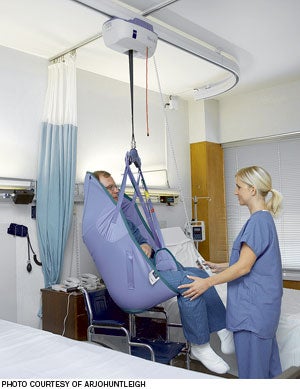Industry urges systematic approach to lifting solutions
 |
| AjroHuntleigh's Mazi Sky ™ ceiling lift system in a typical hospital application. |
Senate legislation intended to protect nurses and other health care workers from injuries related to manual patient lifting appears to be heading in the right direction to support workers. However, the accelerated implementation greatly concerns the Facility Guidelines Institute (FGI) and the American Society for Healthcare Engineering (ASHE).
The bill could create havoc, panic and a waste of resources for hospitals if not accomplished in a systematic manner and not allowed sufficient time to achieve its objectives, testified Douglas S. Erickson, FASHE, CHFM, HFDP, CHFM, CHC, chairman of Guidelines for Design and Construction of Health Care Facilities.
Erickson testified May 11 before the Senate Employment and Workplace Safety Subcommittee of the Senate Health, Education, Labor and Pension Committee on Senate Bill 1788: The Nurse and Health Care Worker Protection Act of 2009. U.S. Senator Al Franken (D-Minn.) introduced the bill last October as a companion measure to H.R. 2381.
Erickson, who also serves as deputy executive director of ASHE, said at the hearing that he is not against a safe patient-handling bill. He also emphasized that legislation to "protect the health care worker from injury and to support safe movement of patients in health care facilities is extremely important."
FGI and ASHE oppose the Senate bill in large part because it does not permit the systematic evaluation of need for mechanical lifting devices and would require installation of mechanical devices in all clinical areas within a three-year period. The legislation also does not take into account that many U.S. hospitals are too old to accommodate ceiling- or wall-mounted patient lifts, either structurally or because patient rooms often are too small.
"From my experience, I do not believe [an Occupational Safety and Health Administration (OSHA)] approach to safe patient handling is the best approach," Erickson testified. "The safe patient handling and lift standards as presented will not allow enough time to alter the built environment and install mechanical lifting devices before the no-lift policy is mandated, resulting in OSHA-levied fines."
The Senate bill would mandate OSHA to develop a safe- patient handling and injury prevention standard within one year of the bill's enactment. The standard would require the use of lift equipment to move patients except in cases that would compromise patient care. A final rule would be issued within two years of enactment.
Hospitals and health care facilities would then need to develop and implement a safe patient and injury prevention plan within six months of the final rule's publication and employers would have to purchase, use, maintain and have accessible an adequate number of safe-lift mechanical devices not later than two years after the issuance of the final regulation.
The job of modifying the nation's health care facilities to provide mechanical lifting equipment to fully support a no-lift policy throughout the health care system will take 10 years or more to achieve, Erickson testified.
More practical solutions already exist, Erickson said. He testified that the authors of the Guidelines for Design and Construction of Health Care Facilities have undertaken a national effort to develop quality standards for assessing patient-handling risks and implementing a program to install mechanical lift devices in new and renovated facilities. He also testified that a 116-person multidisciplinary committee worked with patient-handling experts and other professionals to develop patient handling and movement assessment standards.
A compilation of the patient-handling provisions are in the 2010 guidelines and "Patient Handling and Movement Assessments: A White Paper," both of which can be found online at www.fgiguidelines.org.




